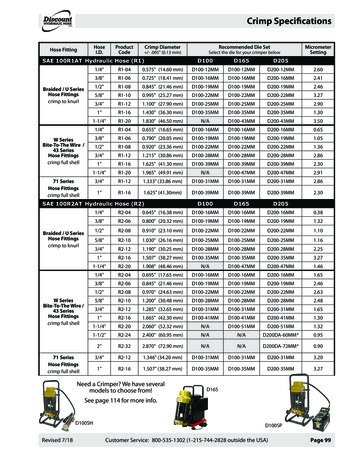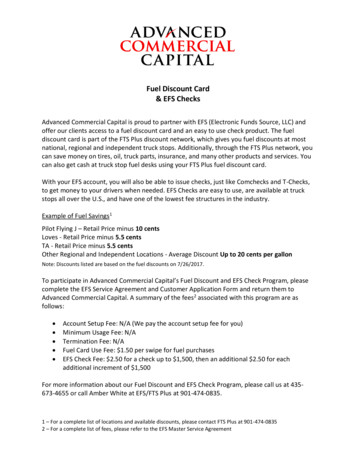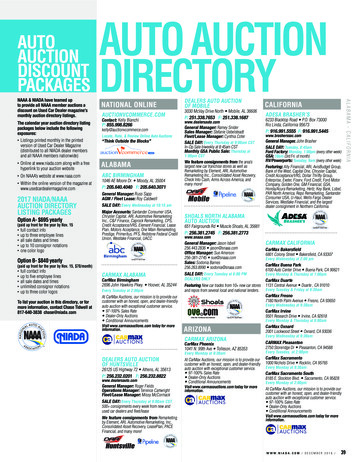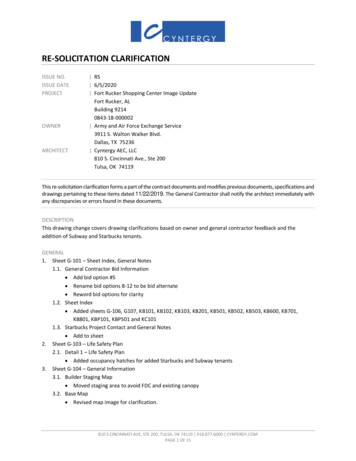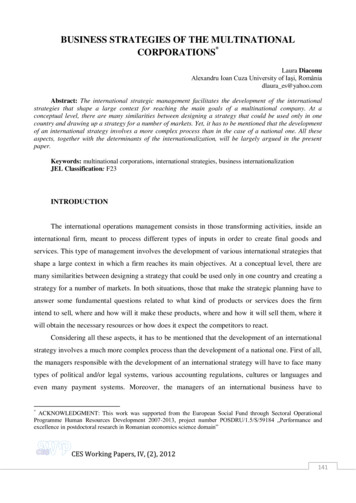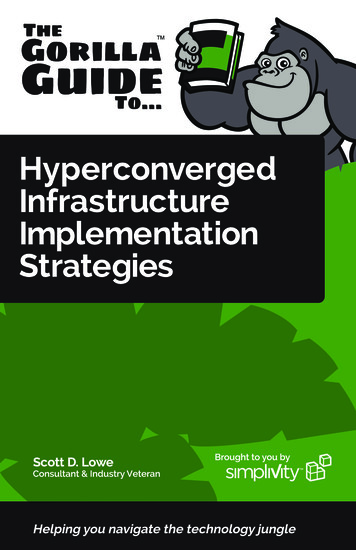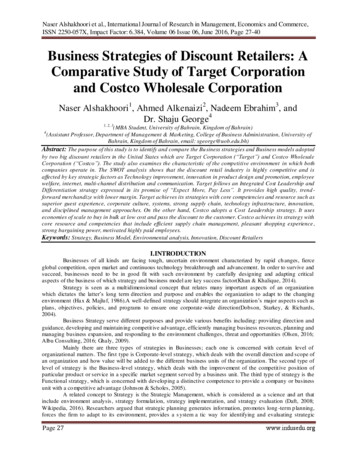
Transcription
Naser Alshakhoori et al., International Journal of Research in Management, Economics and Commerce,ISSN 2250-057X, Impact Factor: 6.384, Volume 06 Issue 06, June 2016, Page 27-40Business Strategies of Discount Retailers: AComparative Study of Target Corporationand Costco Wholesale CorporationNaser Alshakhoori1, Ahmed Alkenaizi2, Nadeem Ebrahim3, andDr. Shaju George41, 2, 3(MBA Student, University of Bahrain, Kingdom of Bahrain)(Assistant Professor, Department of Management & Marketing, College of Business Administration, University ofBahrain, Kingdom of Bahrain, email: sgeorge@uob.edu.bh)Abstract: The purpose of this study is to identify and compare the Bu siness strategies and Business models adoptedby two big discount retailers in the United States which are Target Corporation (“Target”) and Costco WholesaleCorporation (“Costco”). The study also examines the characteristic of the competitive environment in which bothcompanies operate in. The SWOT analysis shows that the discount retail industry is highly competitive and isaffected by key strategic factors as Technology improvement, innovation in product design and promotion, employeewelfare, internet, multi-channel distribution and communication. Target follows an Integrated Cost Leadership andDifferentiation strategy expressed in its promise of “Expect More, Pay Less”. It provides high quality, trend forward merchandize with lower margin. Target achieves its strategies with core competencies and resource such assuperior guest experience, corporate culture, systems, strong supply chain, technology infrastructure, innovation,and disciplined management approaches. On the other hand, Costco adopts a Cost Leadership strategy. It useseconomies of scale to buy in bulk at low cost and pass the discount to the customer. Costco achieves its strategy withcore resource and competencies that include efficient supply chain management, pleasant shopping experience ,strong bargaining power, motivated highly paid employees.Keywords: Strategy, Business Model, Environmental analysis, Innovation, Discount Retailers4I.INTRODUCTIONBusinesses of all kinds are facing tough, uncertain environment characterized by rapid ch anges, fierceglobal competition, open market and continuous technology breakthrough and advancement. In order to survive andsucceed, businesses need to be in good fit with such environment by carefully designing and adapting criticalaspects of the business of which strategy and business model are key success factor(Khan & Khalique, 2014).Strategy is seen as a mult idimensional concept that relates many important aspects of an organizationwhich dictates the latter‘s long term direction and purpose and en ables the organization to adapt to the changingenvironment (Hax & Majlu f, 1986).A well-defined strategy should integrate an organization‘s major aspects such asplans, objectives, policies, and programs to ensure one corporate-wide direction(Dobson, Starkey, & Richards,2004).Business Strategy serve different purposes and provide various benefits including: providing direct ion andguidance, developing and maintain ing competit ive advantage, efficiently managing business resources, planning andmanaging business expansion, and responding to the environment challenges, threat and opportunities (Olsen, 2016;Albu Consulting, 2016; Ghaly, 2009).Mainly there are three types of strategies in Businesses; each one is concerned with certain level oforganizational matters. The first type is Corporate-level strategy, which deals with the overall direct ion and scope ofan organization and how value will be added to the different business units of the organization. The second type oflevel of strategy is the Business-level strategy, which deals with the improvement of the competit ive position ofparticular product or service in a specific market segment served by a business unit. The third type of strategy is theFunctional strategy, which is concerned with developing a distinctive competence to provide a company or businessunit with a co mpetit ive advantage (Johnson & Scholes, 2005).A related concept to Strategy is the Strategic Management, which is considered as a science and art thatinclude environment analysis , strategy formulat ion, strategy implementation, and strategy evaluation (Daft, 2008;Wikipedia, 2016). Researchers argued that strategic planning generates information, pro motes long -term p lanning,forces the firm to adapt to its environment, provides a s ystem a tic way for identifying and evaluating strategicPage 27
Naser Alshakhoori et al., International Journal of Research in Management, Economics and Commerce,ISSN 2250-057X, Impact Factor: 6.384, Volume 06 Issue 06, June 2016, Page 27-40opportunities, stimu lates new ideas, increases motivation and commit ment, and reduces focus on operational details,all of which improve firm performance(Hopkins & Hopkins, 1997).Wheelen & Hunger (2012) suggested four approaches for strategic decision making; Entrepreneurialapproach where strategy is made by one powerful individual and it focuses on opportunities, Adaptive approachwhich is reactive in nature and seeks to provide solutions to existing problems, Planning approach which ischaracterized by systematic gathering of information to analysis the situation and to generate alternative feasiblesolutions, and finally Logical incremental approach which is a mix of the other approaches and is fo rmed as a resultof debates and experimentations.II. REVIEW OF LITERATUREBusiness StrategyAccording to Nickols (2016), the concept of strategy was firstly used in the military field then it wasadapted and use in Business. He suggested that strategy is about bridging the gap between means (e.g. programs,tactics and policies) and ends (e.g. mission and goals). Nickols (2016) summarized the definitions of strategy ofother researchers as ―a complex web of thoughts, ideas, insights, experiences, goals, expert ise, memories,perceptions, and expectations that provides general guidance for specific actions in pursuit of particu lar ends‖.Johnson, Scholes, & Whittington (2008) defined strategy in a comprehensive term as ―the direction andscope of an organization over the long term, wh ich achieves advantage in a changing environment through itsconfiguration of resources and competences with the aim of fulfilling stakeholder expectations‖. This advantage isreferred to as Competitive advantage which includes all the moves and approaches taken to gain an edge overrivals(Po rter, 1996; Po rter, 1980).Mintzberg (1994) suggested that strategy can be defined in mu ltiple ways such as plan to reach targets, apattern of actions over time, a product positioning in particular market and as a perspective that set the direction ofthe organization. Porter (1996) argued that strategy is also about creating strategic fit among a company‘s activities,which will co mplement one another which make it very difficult for rivals t o imitate as they have to match thewhole system. On this context, matching a competitor‘s strategy is harder if we put into consideration that a fitbetween a company‘s activities is usually coupled with a series of operational effectiveness programs.In a competitive environment, firms follow a number of generic strategies which include cost leadership,differentiation, and market focus strategy. A firm will be performing lo wer than its competitors if it does not adoptany of the generic strategies (Porter, 1980).Daft (2008) defined Strategic Management as ―the set of decisions and actions used to formu late andimplement strategies that will provide a co mpetitively superior fit between the organization and its environment soas to achieve organizational goals‖. It is a process that includes identifying external opportunities and thread andinternal strengths and weaknesses, setting the organization mission and objectives, formulat ing strategies andpolicies, developing operational plans, setting budget and procedures, evaluating the end results and makingcorrection based on the dynamic feedback between the all co mponents of the strategy management (Wheelen &Hunger, 2012).Johnson et al (2008) suggested a model of three main elements that constitute the strategic management.The first element is about understanding the strategic position which includes identifying the key environmentalimpacts on the organization and the organization‘s resources and core competencies. The second element of themodel is the strategic Choices which involve understanding the bases of the competitive advantage and futurestrategy. The third element of the strategic management is about putting strategy into action and make sure it isworking as indented.Stevenson (2014) suggested a number of guidelines to ensure successful strategy execution and translatethe strategies into great performance; first, formulate and commun icate clear, focus strategy. Second, align strategywith the current market demands. Third, make sure strategy is matching and supported by the organization culture.Forth, ensure the behaviors of both executives and middle management are in line with the strategy. Fifth, alignhiring, train ing, rewards, and the individual and operational goals with the company strategy(Stevenson, 2014).Business ModelCasadesus-Masanell & Ricart (2010) attributed the origin of the Business Model to Peter Drucker. Theterms ―St rategy‖ and ―Business Model‖ are used interchangeably in art icles and literature and therefore confusio nmay arise between the two interrelated concepts because of the wide use of the term business model in many crit icalareas of the business such as business purpose, processes, offerings, customers, segments, structure, policies andculture(Wikipedia, 2016). Therefore, Strategy and Business Model may look similar; however, they are distinctPage 28
Naser Alshakhoori et al., International Journal of Research in Management, Economics and Commerce,ISSN 2250-057X, Impact Factor: 6.384, Volume 06 Issue 06, June 2016, Page 27-40concepts. Business Model refers to the business logic of the organization and the way it operates and creates valuefor its stakeholders, whereas, Strategy includes choosing a business model that fit the organization situation. Thus,business model is part of the firm overall strategy and is considered a direct result of the chosen strategy(Casadesus Masanell & Ricart, 2010) and it should embodied the management‘s hypothesis about customers demand and themanagement philosophy about the organization‘s design and structure that will translate demands into values for allstakeholders(Teece, 2010).Amit & Zott (2006) stated that ―a business model depicts the content, structu re, and governance oftransactions designed so as to create value through the explo itation of business opportunities‖. .Casadesus -Masanelland Ricart (2010) suggested that business model can be exemp lified with a machine which is configured andprogrammed to operate in certain way (logic) to create a value for its user.Drucker (1954) argued that a successful business model should provide answers to two strategic questions;―Who is the customer and what does the costumer value?‘ and ‗What is the underlying economic logic that explainshow we can deliver value to customers at an appropriate cost?‘. Moreover, a well -designed business model can leadsto a sustainable competitive advantage especially if it is designed with high differentiation, innovative ideas andtechnological competencies. Such model will be d ifficult to be imitated by the competitors (Teece, 2010).Osterwalder, Pigneur, &Tucci (2005) identified nine important building blocks of any business model;Product‘s Value Proposition, Target Customers, Distribution Channel, Customer Relationship, ResourcesConfigurat ion, Co re Co mpetencies, Network with Partners, Cost Structure, and Revenue Model.Today‘s diverse and dynamic environ ment requires both business strategies and business models to bemonitored and evaluated continually and adjusted as and when necessary, what used to be an advantage may turns tobe a disadvantage and the firm become the v ictim of its model or and strategy (Mourdoukoutas, 2016).III. OBJECTIVES OF THE STUDY1.2.3.To identify the business strategies and business model adopted by Target Corporation and CostcoWholesale Corporation.To examine the characteristic of the competitive environment in which Target Corporation and CostcoWholesale Corporation operate in.To compare the business strategy and business model of both Target Corporation and Costco WholesaleCorporation.IV. METHODOLOGYA comparative case study was conducted which relied on collecting, comparing and analyzing secondarydata about Target Corporation and Costco Wholesale Corporation. The analysis aims to identify the similarit ies,differences and patterns in the business strategies and business models of the companies.All data were sourced from published journal articles, books, online articles, case studies, an d companies‘specific published contents including annual reports, marketing materials, profiles, news and the web sites of the twoorganizations.Background of the companiesTarget CorporationToday Target Corporation (―Target‖) is considered the second-largest discount retailers in the UnitedStates. Founded by George Dayton as Good fellow Dry Goods in 1902 in Miineapolis, Minnesota, the company wasrenamed several times and became Target Corporation in 2000. The first Target discount store was es tablished in1962 as subsidiary of Dayton Dry Goods Company. The name ―Target‖ was chosen to distinguish the discount storefro m the depart ment stores(Wikipedia, 2016).As of 2015, Target operates in more than 1790 stores across the United States with aro und 347,000 fu ll andpart time team members(Target, 2016). On January 2011, Target started expanding internationally in Canadathrough purchasing the leaseholds of the 220 Canadian retail chain stores ―Zellers‖. However, the expansion plan toCanada was n
Business Model refers to the business logic of the organization and the way it operates and creates value for its stakeholders, whereas, Strategy includes choosing a business model that fit the organization situation. Thus, business model is part of the firm overall strategy and is considered a direct result of the chosen strategy(Casadesus -


